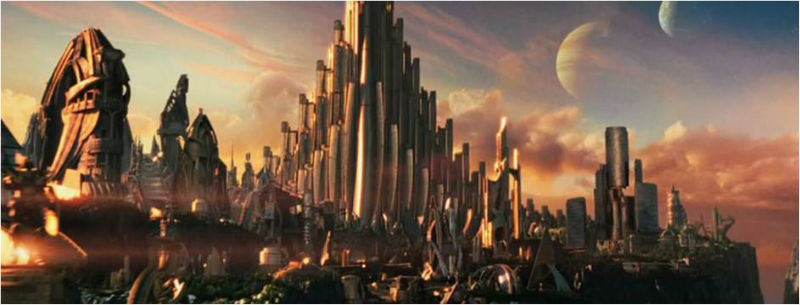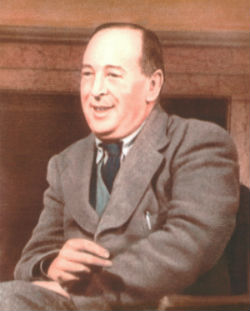
By Neil Earle
American popular film seems addicted to the Superhero phenomenon.
Disney Studios released their second “Thor” epic on November 8 to fairly good reviews. Thor has moved from Norse god to 1960s comic book stalwart to 1970s Saturday morning cartoon presence to this multi-million dollar series starring Chris Helmsworth and Natalie Portman. Mega-star Anthony Hopkins returns as Odin. The sets are once again superb and Thor’s heavenly home of Asgard (pictured, above), says LA Weekly, “is twinklier than ever.”
Disney’s takeover of the prestigious Marvel comic franchise led to a $1.5 billion box office take with “The Avengers” in 2011. But though Hollywood folk lament the crash of the Green Lantern movie that same year, still…generally speaking a superhero extravaganza is a good financial bet. Why is this? And what does it tell about us as a mass audience…and as a human race? Or are we taking all this too seriously?
No. Not at all.
Heroes have been with us since the dawn of time, as Homer’s Iliad makes clear with Achilles and Hector facing off outside the walls of windy Troy. Joseph Campbell, the heralded student of myth and culture, excavated some of the fascination with heroes from Tom Mix and Gene Autry, Davy Crockett and Zorro. This is a well-known trajectory. To have passed through the anti-hero phase from “Bonnie and Clyde” and “Butch Cassidy” to the four heroic set pieces crammed into the summer of 2011 indicates a phenomenon at work. Thus a new “Batman” franchise was planned almost before Christian Bale could get his cape on for his own episode three.
Is there something metaphysical at work here? The futurist Aldous Huxley asserted that the artists were the “antennae” of a society. They capture and reflect the signs of their times for everyone to see. For example, Charles Dickens’ London and Zane Grey’s West. But is this asking too much of the cinematic arts, “the movies”?
European-born film critic Siegfried Kracuer tried to probe the subdued psychological themes in the movies, “those deep layers of collective mentality… below the dimensions of consciousness” (O’Connor and Jackson, American History/American Film, page xi).
O’Connor and Jackson quoted historian Arthur Schlesinger, Jr.’s description of film as “the carrier of deep if enigmatic truths.” The movies “offer the social and intellectual historian significant clues to the tastes, apprehensions, myths, inner vibrations of the age.” There were Busby Berkley’s high-stepping “Gold Digger” movies and “The Grapes of Wrath” in the Great Depression. There was high flying “Top Gun” in the decade of the “Reagan Rearmament.” Schlesinger claimed that the movies, ”tell us not just about the surfaces but about the mysteries of American life” (pages ix-xiii).
That statement calls for unpacking.
Of course, many see the resemblance between the movie experience and the dream state. It’s dark, you’re in a fairly strange place, normal human interaction is suspended, the colorized performers on screen are blown up to the size of a warehouse wall. Film student Keith Cunningham considers movies as close as most people get to an “out of the body experience” – a transcendent event. Boundaries are down, inhibitions are dulled or enhanced by the background music, some of it world class. All of which means the subconscious is more free to frolic. Meanwhile the drama being enacted tugs us through the dynamics of tension and release, tension and release, planned conflicts that explode with a crescendo, working to the theme of “growth through crisis” (Cunningham, The Soul of Screenwriting, page 267).
There is the Beginning, the Muddle and the End. Superman is forced to adopt an alter ego, suspend normal relationships. In 2012 Captain America and Iron Man had to break out of the barriers imposed upon them by meddling “suits” to achieve their moment of resolution. Ah, sweet corporate revenge! In the latest Thor: The Dark World the hero has to reconcile with his evil sibling Loki to stave off the death of the universe. Brother versus brother. Hmmm. Back to Cain and Abel? Jacob and Esau? Rich Man/Poor man?
Psychoanalyzing movie heroes as pointers to our own struggles and foibles can be a murky business, but one thing is for sure: Heroes keep being invented or reinvented. Ace graphic novelist Grant Morrison is optimistic. He says that “superhero stories are flourishing everywhere because they are a bright flickering sign of our need to move on, to imagine the better, more just and more proactive people we can be” (SUPERGODS: Our World in the Age of the Superhero, page 414.) He has a point. Superman was invented at the end of the Depression-ravaged Hitlerite 1930s.

Okay. But why superheroes right now?
Well, first and most simply, everyone likes a good story, the chance to escape in fantasy once in a while. Plus the super-special “special effects” are getting more and more elaborate. This appeals to the digital generation. Also, escapism is popular in times when the economy is sputtering. The Golden Age of the movies was the 1930s, remember, the Great Depression. The 1970s saw the rise of George Lucas and Stephen Spielberg. There are Christian media analysts who study the issue a bit more deeply. They come up with some fascinating conclusions, as in a title by New Testament professor Bernard Scott, Hollywood Dreams and Biblical Stories..
Scott argues that Myths, in the sense of widely-appealing stories, embody tried and true values of the group or tribe. They get their energy from a problem or a crisis to be solved or a lesson to be learned. Most important in all this is that the characters who challenge us, rescue us or transform us must do their work indirectly, at a deep subterranean level. No-one wants to be preached at when passing the popcorn. Yoda scolds “young Skywalker” but it is more entertaining than being disciplined by dad.
The back story is everything. Superman is the ultimate alien, the visitor from Krypton whose father sends him to earth from a planet about to be destroyed – scary overtones in an age of nuclear accidents. The Lone Ranger begins as a peace officer riding into an ambush but is delivered from death by the ministrations of his Indian companion. Everyone needs a helper.
Scott is right when he says that the mythic formula is easy to identify but not easy to put together creatively – one reason movie moguls fear the fate of their celluloid creations. If it were easy, every movie would succeed. They don’t. Scott adds: “One reason a movie does well is that it intersects with basic struggles, conflicts, or tensions within a society in such a way that it provides a temporarily masked resolution to that conflict.”
As the song says, “And then a hero comes along.” He or she resolves anxieties with singular acts of courage, skill and self-sacrifice. And usually great weapons and snazzy outfits. Then there’s the cool weapon. Thor has his hammer, the Lone Ranger his silver bullets, Arthur had Excalibur, Wonder Woman her magic lariat and Superman is well, super.

Movies are our most popular form of story and story, quite frankly, tells a lot about a culture. As Thor the Norse god makes his second appearance on the big screen it brings to mind for some of us the legendary Christian writer C.S. Lewis, (1898-1963). In studying the Northern myths of Odin and Thor as a young student in Belfast, Lewis (pictured, right) was introduced to awe, adoration and wonder. “Pure Northernness engulfed me: a vision of huge clear spaces hanging above the endless twilight of Northern summer, remoteness, severity…Yet unless I am greatly mistaken there was in it something like adoration, some kind of quite disinterested self-abandonment to an object…Sometimes I can almost think that I was sent back to the false gods there to acquire some capacity for worship against the day when the true God should recall me to Himself” (Surprised by Joy, pages 73-77).
Lewis’ sense of cosmic awe at the “out-of-this world spell” of Norse mythology set amid dramatic snows and frosts (Superman too has his icy Fortress of Solitude) set him up for Wagner’s stirring “Ride of the Valkyries.” Something moved the pre-conversion Lewis deep inside. It prepared him emotionally and psychologically, he felt, for accepting what was a much more powerful story – the Master Plot, the key back story to the universe. That involved, of course, the true God sending his Son to earth from the real heaven of heavens to win back the human race through the humble instrument of a wooden cross.
When Lewis was criticized for the violence and warfare in his “Narnia” tales he answered with a reminder of the terrors of growing up and the early cruel defeats of life. He himself had been wounded as a nineteen year old soldier in World War One in France. Life expectancy there was six weeks. If this, said Lewis, is what the world is sometimes like then let children learn of heroic knights and virtuous maidens, of self-sacrifice and daring deeds and visions of becoming larger than life (like the Pevensie children in Narnia). For Lewis, the great myths, the good ones, enshrined solid facts about reality in a creative and imaginative way (The C.S. Lewis Encyclopedia, page 136).
Grant Morrison echoed that theme. “We tend to reenact the stories we tell ourselves.” Alexander the Great slept with a copy of the Iliad under his pillow. Abraham Lincoln studied Henry Clay. There is a power in stories to shape us and at times call us to our higher selves. Lewis knew that. Luke Skywalker has a pressing sense that he is made for more than a bleak existence on barren Tatooine. But he needs Obi Won Kenobi to put it all together. “We need mentors.” Not a bad lesson for a teenager. Or a 65 year old.
Both C.S. Lewis and Joseph Campbell agreed that powerful stories enshrined as collective myths often reflect the struggle deep within us of trying to add meaning to the often random and bitter facts of existence. They tell us what it is like to be human, they symbolize important human yearnings and struggles. Hero stories, said Lewis, with their themes of challenge and quest – these are pointers to what humanity truly values in its heart of hearts, even as they oversimplify. An earlier Superman character a few years back said to Lois Lane, “The world needs a Messiah.” The willingness of the elf princess in Lord of the Rings to give up immortality to marry a mortal is loving sacrifice to the max. Conversely the myth of Narcissus speaks to the ego-maniac in all of us.
“Why do these sacrificial and venture-themed hero patterns keep going around?” interviewer Bill Moyers asked Joseph Campbell. “Because” Campbell replied, “these are the only stories worth telling.” Bingo. Lewis made the point in Mere Christianity that no one ultimately values a man who abandons his friends in times of war.
This explains the jolt of recognition we get from a story or movie or novelistic presentation. Something inside us is stirred. God sent the human race ”good dreams” Lewis wrote, “I mean those queer stories scattered all through the heathen religions about a god who dies and comes to life again and, by his death, has given new life to men.” These, he felt, were preparations for the Gospel, preparations for the most improbable event of all – the true Redeemer Hero appearing in Bethlehem, defeated and then triumphant over death and bringing us with him (in spirit) to a heaven grander than Asgard (Ephesians 2:6).
This is what Lewis meant when he wrote that stirring sentence: “God has landed on this enemy-occupied world in the form of a man” (Mere Christianity, Fount edition, pages 51-53). No wonder Lewis ended up writing three fascinating works of science fantasy. He was trying to make the imagination safe for Christians!
“We are natural poets” Lewis said. Hollywood’s propensity to excavate older stories and to dress them up makes sense in our particular time and place. The age seems to be slipping out of control – tornadoes, floods, radiation leaks, government paralysis. It is not unexpected, then, that in the “waking dream” of the cinema we would be found subconsciously reaching out for some form of deliverance.
“And then a hero comes along…” C.S. Lewis understood and articulated that hero stories can awake our slumbering sensibilities to the truth of a much bigger story, the Gospel. As Paul told the brilliant but paganized Athenians: “Whom you ignorantly worship I declare to you” (Acts 17:23).
Script writer John Truby was adamant that the element of sacrifice, of a moral lesson badly needing to be learned, this provides the solid foundation for most of our movies. To the extent that the movies keep that aspect of Story alive it is perhaps not a bad tactic to try and understand that side of our culture. And to learn to speak more effectively to it. See you at the movies.